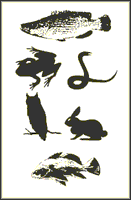Nebraska Cooperative Fish and Wildlife Research Unit

Nebraska Cooperative Fish and Wildlife Research Unit: Staff Publications
Date of this Version
8-21-2019
Citation
2019 The Authors. Ecology and Evolution published by John Wiley & Sons Ltd.
Abstract
1. A long‐standing goal of invasion biology is to identify factors driving highly variable impacts of non‐native species. Although hypotheses exist that emphasize the role of evolutionary history (e.g., enemy release hypothesis & defense‐free space hypothesis), predicting the impact of non‐native herbivorous insects has eluded scientists for over a century.
2. Using a census of all 58 non‐native conifer‐specialist insects in North America, we quantified the contribution of over 25 factors that could affect the impact they have on their novel hosts, including insect traits (fecundity, voltinism, native range, etc.), host traits (shade tolerance, growth rate, wood density, etc.), and evolutionary relationships (between native and novel hosts and insects).
3. We discovered that divergence times between native and novel hosts, the shade and drought tolerance of the novel host, and the presence of a coevolved congener on a shared host, were more predictive of impact than the traits of the invading insect. These factors built upon each other to strengthen our ability to predict the risk of a non‐native insect becoming invasive. This research is the first to empirically support historically assumed hypotheses about the importance of evolutionary history as a major driver of impact of non‐native herbivorous insects.
4. Our novel, integrated model predicts whether a non‐native insect not yet present in North America will have a one in 6.5 to a one in 2,858 chance of causing widespread mortality of a conifer species if established (R2 = 0.91)
5. Synthesis and applications. With this advancement, the risk to other conifer host species and regions can be assessed, and regulatory and pest management efforts can be more efficiently prioritized.
Included in
Aquaculture and Fisheries Commons, Environmental Indicators and Impact Assessment Commons, Environmental Monitoring Commons, Natural Resource Economics Commons, Natural Resources and Conservation Commons, Water Resource Management Commons


Comments
www.ecolevol.org Ecology and Evolution. 2019;9:12216–12230